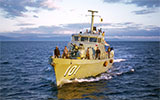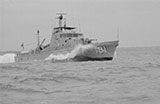Bayonet
![]() Wreck Dive |
Wreck Dive | ![]() Boat access
Boat access
![]()
![]()
![]()
![]()
![]()
Attack Class Patrol Boat | Max Depth: 82 m (269 ft) — Graveyard
The HMAS Bayonet (P 101) was an Attack class patrol boat of the Royal Australian Navy (RAN). (HMAS Advance, a sister ship of the Bayonet, is tied up alongside the Maritime Museum Wharf at Darling Harbour.)
Diving the HMAS Bayonet Shipwreck
The Bayonet shipwreck lies in the Victorian Ships' Graveyard in Bass Strait, settled on the ocean floor in an upright position at a depth of 82 m (269 ft). Around the base of the wreck, steep sand ripples are testament to the strong ocean currents that rage through the area. The state of the hull is surprisingly clean with the painted waterline markings on the bow still readable.
The deck sits at an average depth of 70 m (230 ft). A hole in the foredeck marks where the forward gun once was. In the cabin and inside the wreck in general there is a substantial amount of wiring still present.
Bass Strait Warning: Always keep an eye on sea conditions throughout any shore or boat dive in Bass Strait on Victoria's coastline. Please read the warnings on the web page diving-in-bass-strait before diving or snorkelling this site.
Bayonet Shipwreck Dive Planning
Because of its depth, the Bayonet is a Trimix dive. The protocol used by the Red October Group for their first dive on the wreck used the following conservative dive profile to reduce the inherent risk of DCS. The use of trimix requires each diver to carry four tanks. Their preferred gas mixtures for the Bayonet dive were:
- Nitrox 30 for the travel gas, used from the surface to 30 metres during the descent and from 40 metres to 15 metres during the ascent;
- Trimix 14/45 (14% oxygen, 45% helium) used for the bottom gas between descending past 30 metres and ascending back to 40 metres;
- Nitrox 60 for the decompression gas to be used while ascending from 15 metres.
As an additional safety factor, a diver could choose to breathe pure oxygen in the final 15 minutes of the dive while following a Nitrox 60 decompression schedule. This strategy might further reduce the risk of DCS. Each diver should carry sufficient gas to complete the dive, using the rule of thirds, the optional oxygen bottle (100 cubic foot, 11.1 litres) being attached to the shot line at 3 metres with multiple second stage regulators.
For the initial dive Red October decided to limit their bottom time to 15 minutes. Their dive schedule was calculated with a conservatism factor of 25%, for a total in-water time of 82 minutes comprising of:
- 5 minutes to descend the shot line;
- 10 minutes on the bottom;
- 67 minutes to ascend the shot line and complete all the necessary decompression stops.
Dive schedules should be printed and laminated for underwater use. Dive plans for bottom times of 10, 15, 18 and 20 minutes with bailouts for loss of bottom gas, travel gas and decompression gas should be produced.
The above information is a guide only. Your dive team should make their own dive plans based on their experience and available gases and equipment.
HMAS Bayonet Shipwreck History and Specifications — Built in 1968
The HMAS Bayonet was laid down by Walkers Limited at Maryborough, Queensland in October 1968, launched on 6 November 1968, commissioned on 22 February 1969, and assigned for coastal patrol duties. The ship's company consisted of three officers and sixteen sailors. She was designed to travel at speeds up to 24 knots (44 kpm) and had 20 identical sister ships.
She continued her service as a patrol boat for many years. The Bayonet was transferred to the Melbourne Port Division of the Royal Australian Naval Reserve on 27 March 1982 and used as a training vessel for new cadets.
Built in 1968 and scuttled on 21 September 1999, the overall length of the vessel was approximately 32.6 m (107 ft), beam 6.1 m (20 ft) with a displacement weight of 150 l-ton (152 t).
Propulsion machinery consisted of two 16-cylinder Paxman YJCM diesel engines, which supplied 3,460 shaft horsepower (2,580 kW) to the two propellers. The vessels could achieve a top speed of 24 knots (44 kpm) and had a range of 1,200 nm (2,222 km) at 13 knots (24 kpm). The main armament was a bow-mounted Bofors 40 mm gun, supplemented by two .50 calibre M2 Browning machine guns and various small arms.
HMAS Bayonet Sinking — Scuttled 21 September 1999
Bayonet was paid off on 26 June 1988. HMAS Bayonet was to be scuttled for recreational diving in 30 m (98 ft) of water outside Port Phillip Heads. However, a last-minute decision by the Navy saw this plan abandoned for her disposal in deep water. Defence Maritime Services (DMS) staff scuttled the vessel on 21 September 1999 in deep water off Cape Schanck.
The wreck site was located on 23 December 2001 by the Red October Group, being the culmination of 12 months planning and lead up dives.
See also Wikipedia: HMAS Bayonet (P 101),
Australian National Shipwreck Database: Bayonet, and
Heritage Council Victoria: Bayonet.
Heritage Warning: Any shipwreck or shipwreck relic that is 75 years or older is protected by legislation. Other items of maritime heritage 75 years or older are also protected by legislation. Activities such as digging for bottles, coins or other artefacts that involve the disturbance of archaeological sites may be in breach of the legislation, and penalties may apply. The legislation requires the mandatory reporting to Heritage Victoria as soon as practicable of any archaeological site that is identified. See Maritime heritage. Anyone with information about looting or stolen artefacts should call Heritage Victoria on (03) 7022 6390, or send an email to [email protected].
Finding the HMAS Bayonet Shipwreck
Over the years we've been provided with different GPS marks for the Bayonet shipwreck. The GPS marks we know of in circulation for the Bayonet are:
- GPS
Latitude: 38° 43.050′ S (38.7175° S / 38° 43′ 3″ S)
Longitude: 144° 35.250′ E (144.5875° E / 144° 35′ 15″ E) - eChart Mark
Latitude: 38° 43.049′ S (38.717479° S / 38° 43′ 2.92″ S)
Longitude: 144° 35.273′ E (144.587888° E / 144° 35′ 16.4″ E)
34 m, bearing 86°, E - Mystery GPS Mark
Source: Dive Victoria:
Latitude: 38° 43.493′ S (38.72488333° S / 38° 43′ 29.58″ S)
Longitude: 144° 35.249′ E (144.5874833° E / 144° 35′ 14.94″ E)
821 m, bearing 180°, S
Packo seems to think the mystery GPS mark is the result of a latitude stuff-up with a wrong decimal place and we believe him. Thus there is no point in going there.
Traditional Owners — This dive site does not lie in the acknowledged traditional Country of any first peoples of Australia.
Bayonet Location Map
Latitude: 38° 43.050′ S (38.7175° S / 38° 43′ 3″ S)
Longitude: 144° 35.250′ E (144.5875° E / 144° 35′ 15″ E)
Datum: WGS84 |
Google Map
Added: 2012-07-22 09:00:00 GMT, Last updated: 2022-05-04 02:26:01 GMT
Source: GPS
Nearest Neighbour: Helen, 25,482 m, bearing 63°, ENE
Attack Class Patrol Boat, 150 ton.
Built: Queensland, 1968.
Sunk: 21 September 1999.
Victorian Ships' Graveyard, Bass Strait.
Depth: 82 m.
[ Top ]
DISCLAIMER: No claim is made by The Scuba Doctor as to the accuracy of the dive site coordinates listed here. Should anyone decide to use these GPS marks to locate and dive on a site, they do so entirely at their own risk. Always verify against other sources.
The marks come from numerous sources including commercial operators, independent dive clubs, reference works, and active divers. Some are known to be accurate, while others may not be. Some GPS marks may even have come from maps using the AGD66 datum, and thus may need be converted to the WGS84 datum. To distinguish between the possible accuracy of the dive site marks, we've tried to give each mark a source of GPS, Google Earth, or unknown.




